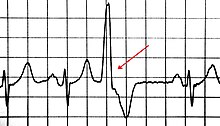Premature heart beat
| Premature heart beat | |
|---|---|
 | |
| A premature ventricular contraction marked by the arrow | |
| Specialty | Cardiology |
A premature heart beat or extrasystole[1] is a heart rhythm disorder corresponding to a premature contraction of one of the chambers of the heart. Premature heart beats come in two different types: premature atrial contractions and premature ventricular contractions. Often they cause no symptoms but may present with fluttering in the chest or a skipped beat. They typically have no long term complications.
They most often happen naturally but may be associated with caffeine, nicotine, or stress. Usually no treatment is needed. They are the most common arrhythmia.[2]
Physiopathology
The normal heart contraction comes from a cyclic membrane depolarization (reversal of the electrical polarity of the cell membrane) of a group of cells located on the upper part of the right atrium, the sinoatrial node. This depolarization spreads to the whole heart and causes muscle cells to contract. It is followed by a "refractory period", a short time when the cells are no longer stimulable. The heart rate is controlled by this node.
Diagnosis


Premature heart beats can be asymptomatic (the patient does not complain about anything). The subject may experience palpitations, a feeling of cardiac "pause". Taking (prolonged) pulse may result in a rhythm that seems irregular. Electrocardiography and laser Doppler imaging[3] allow to visualize premature heart beats. From their appearance, their location can be assessed. The Holter monitor allows to quantify them, to specify their characteristics and their repetition.
Types
- Premature atrial contraction (PAC)
- Supraventricular extrasystoles (SVES)
- Premature ventricular contraction (PVC)
- Ventricular extrasystoles (VES)
- Premature junctional contraction
References
- ^ "Premature ventricular contractions (PVCs)". Mayo Clinic. April 30, 2022. Retrieved June 1, 2022.
- ^ "Types of Arrhythmia". nhlbi.nih.gov. July 1, 2011. Archived from the original on June 7, 2015. Retrieved March 7, 2015.
- ^ Puyo L, Paques M, Fink M, Sahel JA, Atlan M (October 2019). "Waveform analysis of human retinal and choroidal blood flow with laser Doppler holography". Biomedical Optics Express. 10 (10): 4942–4963. doi:10.1364/BOE.10.004942. PMC 6788604. PMID 31646021.

